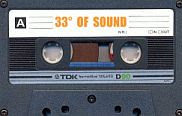
Named in direct response to Marvin Gaye’s soulful, anguished questioning of the socio-political landscape, "What’s Going On?" (released a few months earlier), "There’s a Riot Going On” (1971), another example of a Transtemporal album, was the fifth studio album by American funk and soul band Sly & the Family Stone, released on November 20, 1971. In contrast to their previous studio work with psychedelic soul, hand-claps, and ‘loved-up’ grooves, as featured on Stand! (1969), "There’s a Riot Goin’ On" embraces a darker, more foreboding funk sound, while also rejecting the band's successful melodic formula that was featured on their previous hit singles.
The original cover art for Riot featured a red, white, and black American flag with suns in place of the stars. No other text or titles appear on the cover. Stone later explained the album cover's concept in relation to Riot's theme, stating
"I wanted the flag to truly represent people of all colors. I wanted the color black because it is the absence of color. I wanted the color white because it is the combination of all colors. And I wanted the color red because it represents the one thing that all people have in common: blood. I wanted suns instead of stars because stars to me imply searching, like you search for your star. And there are already too many stars in this world. But the sun, that's something that is always there, looking right at you.The entire record featured a dampened, dub-like sound as the result of Sly's extensive re-recording and overdubbing, which matches the burnt-out, frustrated, drugged tone of Sly's lyrics and vocals. Riot finds Sly reveling in drug-induced euphoria ("Luv n' Haight"), praising himself ("Poet") and declaring that the good times and high hopes of 1960s are over, and the bad times (the 1970s) are here ("Africa Talks to You 'The Asphalt Jungle'").
"Thank You For Talking to Me Africa" is a slower, ghastly, yet still forceful version of the previously released "Thank You (Falettinme Be Mice Elf Agin)". The song's lyrics, like many of the themes on the album, feature the concept of the disillusionment of the soul. Critic Matthew Greenwald praised the song's concept, writing:
The closing track on "There’s a Riot Goin’ On" is perhaps the most frightening recording from the dawn of the 1970s, capturing all of the drama, ennui, and hedonism of the decade to come with almost a clairvoyant feel. The original song was itself a terrifying look at urban tension, couched in a blues-gospel motif, and this extended (and again, much slowed down and bluesy) version reminded listeners that, indeed, "the dream was over" as the '60s drew to a close. "Runnin' Away" deals with the paranoia and poverty, casued by incessant drug taking. The jolty, perky guitar strumming and vocals deceptively masking a desperate narrative, keen to escape. To juxtapose, "(You Caught Me) Smilin'" is simply a hymn to getting high. Thom Jurek wrote of this track: "It is introduced by a slow, wispy soul that sounds like it's drifting in from a distant radio somewhere... Sister Rose's voice is all sweet, and at first so is Sly's, but as the horns and bassline come stepping in, Sly's voice gets heavy and is distorting in places deliberately. The delicate keyboard lines, luxuriant and in the pocket as they are, cannot keep the voice contained. There's a minimal instrumental break in the tune and it suddenly fades just as it emerged. Side one technically concludes with the album's title track, which is silent, and listed as being zero minutes and zero seconds long." Sly Stone later explained that the song had no running time because
"I felt there should be no riots." Upon release, "There’s a Riot Goin’ On" received mixed reviews from fans and critics who were not used to the album's general mood and lyrical content, despite achieving commercial success with two hit singles and debuting at number-one on the Billboard Pop Albums and Soul Albums chart. While Sly Stone's previous body of work consisted of mostly optimistic R&B and psychedelic soul music, some major music publications praised this new, darker direction and composition. Music critic and writer Greil Marcus cited "There’s a Riot Goin’ On" as
"Muzak with its finger on the trigger." Vince Aletti wrote...
"Maybe this is the new urban music. It's not about dancing to the music, in the streets. It's about disintegration, getting fucked up, nodding, maybe dying. There are flashes of euphoria, ironic laughter, even some bright stretches but mostly it's just junkie death, oddly unoppressive and almost attractive in its effortlessness. Like going to sleep very slowly. The music has no peaks, no emphasis, little movement; it seems to fall away like a landslide in a dream (you falling slowly too, not panicking) or merely continue, drained of impetus, self-destructing. Smack rock... But once you get into the haze of it, it can be rather beautiful: measured, relaxed, hypnotic... At first I hated it for its weakness and its lack of energy and I still dislike these qualities. But then I began to respect the album's honesty... It's hard to take, but "There’s a Riot Goin’ On" is one of the most important fucking albums this year." Writer Robert Christgau cited the album as
"Despairing, courageous, and very hard to take, this is one of those rare albums whose whole actually does exceed the sum of its parts... The inspiration may be Sly's discovery that the pot of gold at the end of the rainbow doesn't mean shit, but what's expressed is the bitterest ghetto pessimism." Many years later, he concluded
"1969's Stand! Revealed the magnificence of which this band would all too briefly be capable... Sly Stone had 'Made It'. But its temptations and contradictions ate him up. The result was the prophetic 1971 "There’s a Riot Goin’ On", recorded in anarchic, druggy torpor over a year, or was it two, Stone didn't know the difference. Its taped-over murk presaging Exile on Main St., its drum-machine beats throwing knuckleballs at Miles and JB, it was darker than the Velvet Underground and Nico and funkier than shit, yet somehow it produced two smash hits, including the stark, deep "Family Affair". Following initial mixed reaction to the album, "There’s a Riot Goin’ On" has earned a legacy as one of the greatest and most influential albums ever recorded. It is also considered one of the first instances of the type of funk music later popularised by George Clinton and Funkadelic, the Ohio Players, and similar acts. “There’s a Riot Goin’ On” , as well as the follow-up efforts Fresh, and Small Talk are considered among the first and best examples of the matured version of funk music, after prototypical instances of the sound in Sly & the Family Stone's 1960s work. The album's unique sound also influenced legendary jazz musicians Miles Davis and Herbie Hancock to crossover to the jazz-funk genre. From the 1970s on, Riot's songs have been extensively covered and sampled. Among the artists who have covered or reworked songs from Riot include Iggy Pop, John Legend, Lalah Hathaway, De La Soul, The Beastie Boys, Gwen Guthrie, and many others. The funk music genre in general, including the works of Sly & The Family Stone and James Brown & The J.B.'s, had great influence on pioneering hip hop acts, such as Afrika Bambaataa, DJ Kool Herc and many others who have sampled their music
"Luv n' Haight" – 4:04
"Just Like a Baby" – 5:13
"Poet" – 3:02
"Family Affair" – 3:08
"Africa Talks to You 'The Asphalt Jungle'" – 8:45
"There’s a Riot Goin’ On" – 0:00
"Brave & Strong" – 3:32
"(You Caught Me) Smilin'" – 2:56
"Time" – 3:05
"Spaced Cowboy" – 3:59
"Runnin' Away" – 2:57
"Thank You for Talkin' to Me, Africa" – 7:18
What’s Going On? There’s a Riot Goin’ On! Indeed.
~










